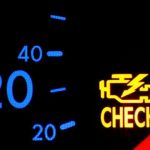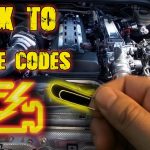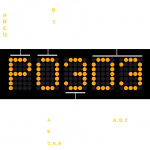
A check engine light is a warning sign that something is wrong with the car’s engine management system (EMS) or another part of the vehicle. It also tells you if the problem is related to the engine’s Diagnostic Trouble Codes (DTCs), five-digit codes that describe a specific problem with the car. The DTCs are displayed on the scanning tool once it connects to the car’s OBD (On-Board Diagnostics) system. Each five-digit DTC has a specific problem and an explanation for the problem.
OBD2
The OBD2 system is a common method of troubleshooting a car, and can retrieve the OBD2 car scan codes from your car. OBD codes are four-digit messages that describe a problem with your car. The first digit specifies the type of code you have. The second digit describes the system your vehicle is affected by, and the last two digits describe the specific fault designation. The codes begin with a letter prefix, then contain a four-digit sequence of numbers.
The OBD2 port is usually located beneath the dashboard or steering column, but it can also be found in areas 4-9. A simple wired hand-held scanner will give you a list of the codes in your vehicle. Before purchasing a scan tool, you may want to read up on common car codes and the meaning of these codes. In many cases, these codes are related to a malfunction with your vehicle’s transmission, fuel system, or steering.
SAE codes
When you’re trying to diagnose on-board vehicle problems, you’ll want to know how to read SAE car scan codes. Unlike odometer readings, these codes have specific meanings and are used by manufacturers to identify faults and perform repairs. EVAP codes, for example, tell you whether the vehicle has a problem with its EVAP system. EVAP is a system that prevents gas fumes from entering the atmosphere, keeping air pollution to a minimum.
Transmission codes, on the other hand, monitor the transmissions of vehicles, most often triggered by faulty computer systems and issues with the speed sensor. While the majority of EVAP codes are generated by the fuel pump, there are also specific codes related to the transmission and the engine. This information is vital to the diagnosis of any on-board vehicle problem, and proper tools are essential to getting
When it comes to diagnosing a specific problem, ISO/SAE codes are often determined by other stored codes, and symptoms also play a role. Regardless of the cause of the problem, it’s important to check TSBs and diagnose other codes present in the vehicle’s computer system. Low voltage is often caused by a number of different factors, but the first step to identifying this problem is to check the voltage at the battery. Otherwise, you’ll need to perform additional tests to find the root of the problem.
Manufacturer-specific codes
How can you identify and diagnose your vehicle’s problems? Using a manufacturer-specific car scan tool can help. These tools work by reading trouble codes and determining the source of the problem. The codes are usually grouped by category, starting with “p” and ending in “u”. The first digit indicates the symptom category while the second digit denotes a subsystem. Once you know the cause of the code, you can proceed to troubleshoot the problem.
First, you need to purchase a manufacturer-specific scan tool. There are many options available in the market. For instance, you can purchase a scan tool that has a manufacturer-specific diagnostic connector. The software will tell you which DTC is responsible for a particular symptom. Once you have installed the scanner, you need to enter the corresponding codes. Most of the diagnostic tools have a one-line description while some come with a detailed code definition.
These trouble codes are not created for every single problem, but they are the result of a malfunction. The codes are not all dangerous, though. Some simply indicate a malfunctioning sensor. Others indicate a malfunction with the vehicle’s emissions control system. Whether you want to diagnose your vehicle’s problems, or just get it back on the road, you must be able to read the codes on your vehicle’s computer. To do this, you need to learn where to look for them. Most vehicles store these codes in the Engine Control Module or the Powertrain Control Module.
EVAP system vent valve
The P0446 error code indicates that the EVAP system vent valve is not functioning properly. It does not create enough pressure to seal properly. The result is an excessive buildup of gas and fuel fumes inside the car. Inhaling gas fumes is extremely harmful. The most common symptoms of the problem are fuel economy loss and gasoline smell. To resolve this problem, you should check your vehicle for any of these symptoms.
If you find a code relating to the EVAP system, you must repair it immediately. It may be caused by a leak, a blocked line, faulty sensors, or a malfunctioning solenoidal. The best solution for your EVAP system fault code is to have your car diagnosed by a mechanic. A professional mechanic can help you determine the exact problem and repair it for free.
Another common cause of code P0446 is a loose gas cap. The gas cap can be loose or deteriorated. To remedy this problem, you can tighten the gas cap. While the gas cap may be visible, the damage it causes may not be visible. A replacement gas cap is inexpensive and easy to do. Regardless of the cause, a replacement gas cap can clear up the P0446 code.
Misfires in a given cylinder
The P0301 diagnostic trouble code means that the engine is misfiring in a given cylinder. The cause can be multiple, from a lack of fuel to an EGR valve issue. It may also be caused by inadequate compression. If your car’s diagnostic trouble code reading is P0301, a mechanic should investigate the problem. The misfire code may be a good indicator of a more serious problem.
In many cases, a misfiring cylinder will produce multiple secondary misfires in the same cylinder bank. One of these secondary misfires can be caused by a clogged primary catalytic converter in the exhaust system. Random misfires are also possible. In this case, you will want to consult the misfire history screen. This will give you valuable clues as to why your car’s engine misfires.
A misfire in one cylinder may be a symptom of another, unrelated problem. For example, a misfire in one cylinder may be a sign of a vacuum leak. A vacuum leak can affect the engine’s idle and fuel economy. The ECM will attempt to correct the problem in one cylinder but will overcompensate for the other cylinders.
Problems with the ignition coil
If you’ve received a scan code for “problems with the ignition coil,” the problem may be something more serious than you initially suspected. The scan code can indicate a number of issues that need further testing. If you see multiple errors, you should seek the help of a professional mechanic. Fortunately, there are several ways to diagnose ignition coil problems and determine the best course of action. Read on to learn more.
If you’re unsure how to test for ignition coil problems, the easiest and most affordable way is to swap the coils in your car. If the code has moved to another cylinder, swap it for another one. If this doesn’t work, you’ll need to look for other malfunctions that affect your car’s ignition system, such as a broken wire or faulty coil. A good diagnostic tool will include information on both the cause and the solution.
The ignition coil receives power from the battery and pulsing ground from the Powertrain Control Module, also known as the PCM. If this voltage is off by about 10%, the problem is with the ignition coil. If the voltage is off by even a little, the problem may be a loose or corroded prong. Otherwise, the ignition coil is the cause of a P0353 code.
Fuel injectors
If your car’s computer displays a code pertaining to the operation of the fuel injectors, it may be a sign that the circuitry for the fuel pump is malfunctioning. Fuel injectors are monitored by the engine control module (ECM), and any malfunctioning injectors may cause the car’s engine to enter failsafe mode. You can use an advanced car scan tool to diagnose the problem.
The first step to diagnosing a problem with the fuel injectors in your car is to perform a diagnostic test. A fuel injector will give off a sharp clicking sound if it is functioning correctly. You can check the injectors yourself by disconnecting the fuel rails. Disconnect the fuel rails from the vehicle and check the hoses for a leak. If you are unsure of how to proceed, you can ask a professional for help.
Identifying the source of this problem is crucial. Fuel injectors can cause an array of problems ranging from drivability problems to safety risks. An advanced diagnostic tool is necessary to properly diagnose a fuel injector issue. By following these steps, you can determine the exact cause of the problem and repair it as soon as possible. This way, you can avoid the hassle of spending hundreds of dollars on an expensive diagnosis.
Exhaust system
If your car’s error code P0420 is indicating that your catalytic converter needs to be replaced, it may be time to bring it to a professional for repair. This code can also be a sign that your catalytic converter isn’t performing as well as it should. In such a situation, it is imperative to check your vehicle’s exhaust system for any damage or leaks. Once these have been repaired, you can clear this code. To confirm that your repairs have resolved the problem, drive your car several times to ensure that it doesn’t return.
Oxygen sensors are located before and after the catalytic converter. These sensors monitor the amount of oxygen the engine burns. If the sensor readings don’t change quickly, or remain high, then it means that your engine is either running rich or lean. If you notice the problem, you should bring it to a mechanic’s attention immediately. If you can’t get the problem resolved, you may want to try a car tune-up service.





